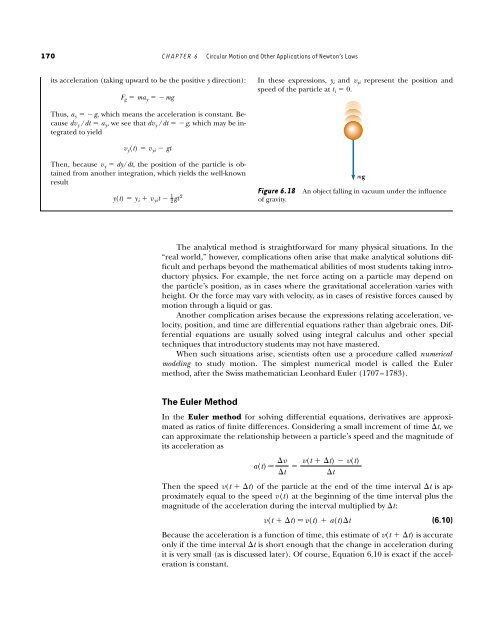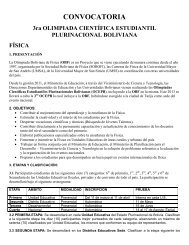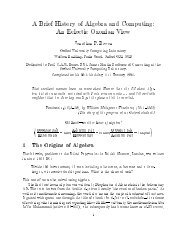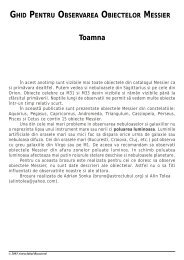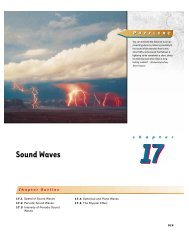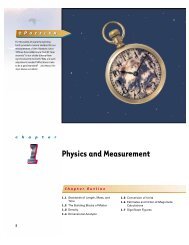Circular Motion and Other Applications of Newton's Laws
Circular Motion and Other Applications of Newton's Laws
Circular Motion and Other Applications of Newton's Laws
You also want an ePaper? Increase the reach of your titles
YUMPU automatically turns print PDFs into web optimized ePapers that Google loves.
170 CHAPTER 6 <strong>Circular</strong> <strong>Motion</strong> <strong>and</strong> <strong>Other</strong> <strong>Applications</strong> <strong>of</strong> Newton’s <strong>Laws</strong><br />
its acceleration (taking upward to be the positive y direction):<br />
F g � ma y ��mg<br />
Thus, ay ��g, which means the acceleration is constant. Because<br />
dvy /dt � ay , we see that dvy /dt ��g, which may be integrated<br />
to yield<br />
v y(t) � v yi � gt<br />
Then, because vy � dy/dt, the position <strong>of</strong> the particle is obtained<br />
from another integration, which yields the well-known<br />
result<br />
y(t) � y i � v yit � 1<br />
2gt 2<br />
The analytical method is straightforward for many physical situations. In the<br />
“real world,” however, complications <strong>of</strong>ten arise that make analytical solutions difficult<br />
<strong>and</strong> perhaps beyond the mathematical abilities <strong>of</strong> most students taking introductory<br />
physics. For example, the net force acting on a particle may depend on<br />
the particle’s position, as in cases where the gravitational acceleration varies with<br />
height. Or the force may vary with velocity, as in cases <strong>of</strong> resistive forces caused by<br />
motion through a liquid or gas.<br />
Another complication arises because the expressions relating acceleration, velocity,<br />
position, <strong>and</strong> time are differential equations rather than algebraic ones. Differential<br />
equations are usually solved using integral calculus <strong>and</strong> other special<br />
techniques that introductory students may not have mastered.<br />
When such situations arise, scientists <strong>of</strong>ten use a procedure called numerical<br />
modeling to study motion. The simplest numerical model is called the Euler<br />
method, after the Swiss mathematician Leonhard Euler (1707–1783).<br />
The Euler Method<br />
In these expressions, y i <strong>and</strong> v yi represent the position <strong>and</strong><br />
speed <strong>of</strong> the particle at t i � 0.<br />
Figure 6.18 An object falling in vacuum under the influence<br />
<strong>of</strong> gravity.<br />
In the Euler method for solving differential equations, derivatives are approximated<br />
as ratios <strong>of</strong> finite differences. Considering a small increment <strong>of</strong> time �t, we<br />
can approximate the relationship between a particle’s speed <strong>and</strong> the magnitude <strong>of</strong><br />
its acceleration as<br />
a(t) �<br />
�v<br />
�t<br />
� v(t ��t) � v(t)<br />
�t<br />
Then the speed v(t ��t) <strong>of</strong> the particle at the end <strong>of</strong> the time interval �t is approximately<br />
equal to the speed v(t) at the beginning <strong>of</strong> the time interval plus the<br />
magnitude <strong>of</strong> the acceleration during the interval multiplied by �t:<br />
v(t ��t) � v(t) � a(t)�t<br />
(6.10)<br />
Because the acceleration is a function <strong>of</strong> time, this estimate <strong>of</strong> v(t ��t) is accurate<br />
only if the time interval �t is short enough that the change in acceleration during<br />
it is very small (as is discussed later). Of course, Equation 6.10 is exact if the acceleration<br />
is constant.<br />
mg


